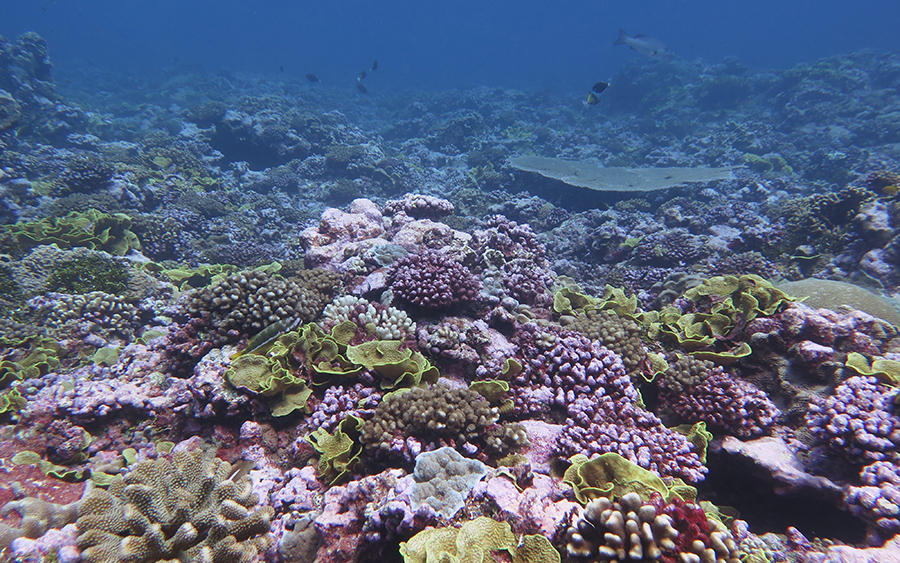
Central Pacific Coral Reef Shows Remarkable Recovery Despite Two Warm-Water Events
Study shows value of looking at long-term trends in face of climate change
Published Date
By:
- Steven Koppes
Share This:
Article Content
The largest global coral-bleaching event ever documented struck the world’s oceans in 2014 and lasted until 2017. The onset of this abnormal whitening condition spawned widespread gloom-and-doom news reports about its calamitous effect on Australia’s Great Barrier Reef and more general predictions of coral reef extinction by 2050.
But a new 10-year study from Palmyra Atoll in the remote central Pacific Ocean shows that reefs outside the reach of local human impacts can recover from bleaching.
“One year after each bleaching event, we did see signs of coral decline at some of the sites, but within two years this was restored,” said Adi Khen, a Scripps Oceanography PhD candidate and lead author. The research team of current and former members in marine ecologist Jennifer E. Smith’s laboratory saw only a small net change in the reef’s coral and algae populations after a decade. Khen, Smith and four co-authors published their results in the journal Coral Reefs.
“This is a testament to the resilience of Palmyra’s reefs in the context of climate change and demonstrates the capacity for recovery in the absence of local stressors,” Khen noted. “Because we have this long-term time series, we’re able to see perspectives from before and after disturbances.”
With support from The Nature Conservancy and the U.S. Fish and Wildlife Service, Smith launched a long-term monitoring effort in 2009 at Palmyra Atoll, located 1,300 kilometers (about 805 miles) south of Hawaii. Palmyra is an American territory populated only by visiting researchers and support staff. As one of the remote Northern Line Islands, it is unaffected by local human impacts such as fishing, pollution, coastal development, and tourism. Palmyra provides a natural laboratory for monitoring how ecosystems change over time in response to climate warming events.
“During the warming event that occurred in 2015, we saw that up to 90% of the corals on Palmyra bleached but in the year following we saw less than 10% mortality,” Smith reported. “Measuring not just death and destruction but measuring recovery is really important. Seeing the recovery is where we can learn what might help inform future management.”
Smith first visited the Palmyra National Wildlife Refuge in 2005, shortly after it was established. The recent paper includes data that Smith or members of her team, diving in scuba gear, collected at least once annually from 2009 to 2018 during visits to the exact same 80 plots spread across eight sites around the atoll along underwater transects.
Using simple image-analysis tools and digital tracing, her team then identifies all bottom-dwelling organisms present in the plots to see if they are increasing or decreasing in abundance. It takes from one to two hours for a team of graduate and undergraduate students to process each image. More than 1,500 images have been taken of the plots so far.
Khen, a National Science Foundation Graduate Research Fellow and a Beyster Family Fellow in Conservation and Biodiversity, also is an affiliated artist of the Climate Science Alliance>. A self-taught digital scientific illustrator, she visited Palmyra Atoll in 2020 as part of an internship with The Nature Conservancy in science communication. She first began researching coral reefs as a UC San Diego undergraduate.
“As a grad student, I had the opportunity to work on this long-term time series, which unlike other reef systems is actually showing signs of hope,” Khen said. “That’s what motivates me to keep going, seeing resilience in nature despite climate change impacts.”
The Palmyra dataset suggests that warm-water events by themselves may cause some decline in reef-building corals and calcifying algae. But the atoll’s clean, protected waters and intact ecosystems harbor a healthy population of fishes that may contribute to the resilience of Palmyra’s reefs.
“These remote, protected reef systems seem to be able to recover much faster than reefs that are adjacent to dense human populations where overfishing, coastal development, and fresh water runoff containing fertilizers and pesticides all may erode the ability of a reef to recover,” Smith said.
Most coral reefs are near large human populations in locations beset with pollution, overfishing, sedimentation, warming and acidification.
“Certainly, they’re going to be more susceptible to large losses,” Smith said. “But to know that places like this are out there showing signs of resistance and resilience gives us hope and also shows us that there’s still a lot to learn about how these intact systems are functioning.”
Besides Khen and Smith, co-authors of the study included Scripps Oceanography PhD alumni Maggie D. Johnson and Michael D. Fox of King Abdullah University of Science and Technology, Samantha M. Clements of Scripps Oceanography and Amanda L. Carter of the National Science Foundation.
The Scripps Family Foundation, the Bohn Family, and the Gordon and Betty Moore Foundation provided funding for this research.
Share This:
You May Also Like
Stay in the Know
Keep up with all the latest from UC San Diego. Subscribe to the newsletter today.



